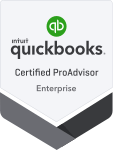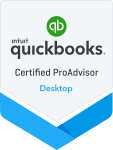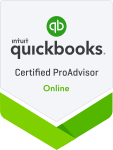Curriculum Day 1
Day 1 Topics for Discussion and Practice:
Getting Started:
Learn how to easily navigate Quickbooks and how each person can customize and create shortcuts for their own preferences and style. Learn tips, tricks, and shortcuts. Learn how to use forms, simplify your data entry, and gain confidence right away that you're doing things correctly.
How the Company is Set Up:
Learn how to setup your company and/or learn about the choices that were made when your company was initially set up. Learn how to customize Quickbooks® and how to set preferences that are specific to your company and to your needs. Learn how to make corrections, fix setup errors, and/or clean up your company without having to start over.
Working with the Lists in Quickbooks:
Add vendor & customer information into Quickbooks® lists; and learn how to fully utilize the customer, vendor, & employee centers. Learn tips for managing the lists such as: sorting, merging, editing, hiding. Learn how to add to, and edit, the Chart of Accounts. Learn how to clean up older or incorrect list items and also how the use of these lists are the key to making Quickbooks run smoothly and efficiently.
Working with Bank Accounts:
Understand the difference between writing checks vs. entering & paying bills. Record bank account entries such as: debit card transactions, hand written checks, phone payments, online banking, and bank transfers. Learn about the reconciliation process; and learn shortcuts on how to reconcile quickly and efficiently. Learn how to find reconciliation errors and how to correct them.
Understanding the Chart of Accounts and other accounts uses:
Introduction and light discussion on other account types in Quickbooks® such as assets, liabilities, and equity. Learn how to track and record credit card purchases and reconcile them quickly.
Tracking Sales in Quickbooks:
Enter sales, track accounts receivable, learn how to work with the Quickbooks item list, how to memorize transactions, how to add price levels, how to apply discounts to customers, and also how to record sales for those of you who do not invoice customers. Receive money and make deposits correctly. Handle partial payments, overpayments, prepayments, and NSF checks. Apply credit memos and discounts easily. Understand the purpose and usefulness of the undeposited funds account. Learn about common deposit mistakes and how to correct them.
Entering & paying bills:
Learn about different options for handling bills and expenses in Quickbooks; and how to pay bills quickly and efficiently. Learn how to easily take discounts for early payments, and how to apply vendor credit memos. Learn the various ways to track your company's expenses, and which option is the most efficient way for you.
Reports:
A basic introduction to the report menu for those who enroll in Day 1 only. Learn how to navigate the report menu and how to find the reports that can assist in your company's business review. A deeper dive into reporting and financial analysis is covered on Day 2 of the Quickbooks Training Class.




